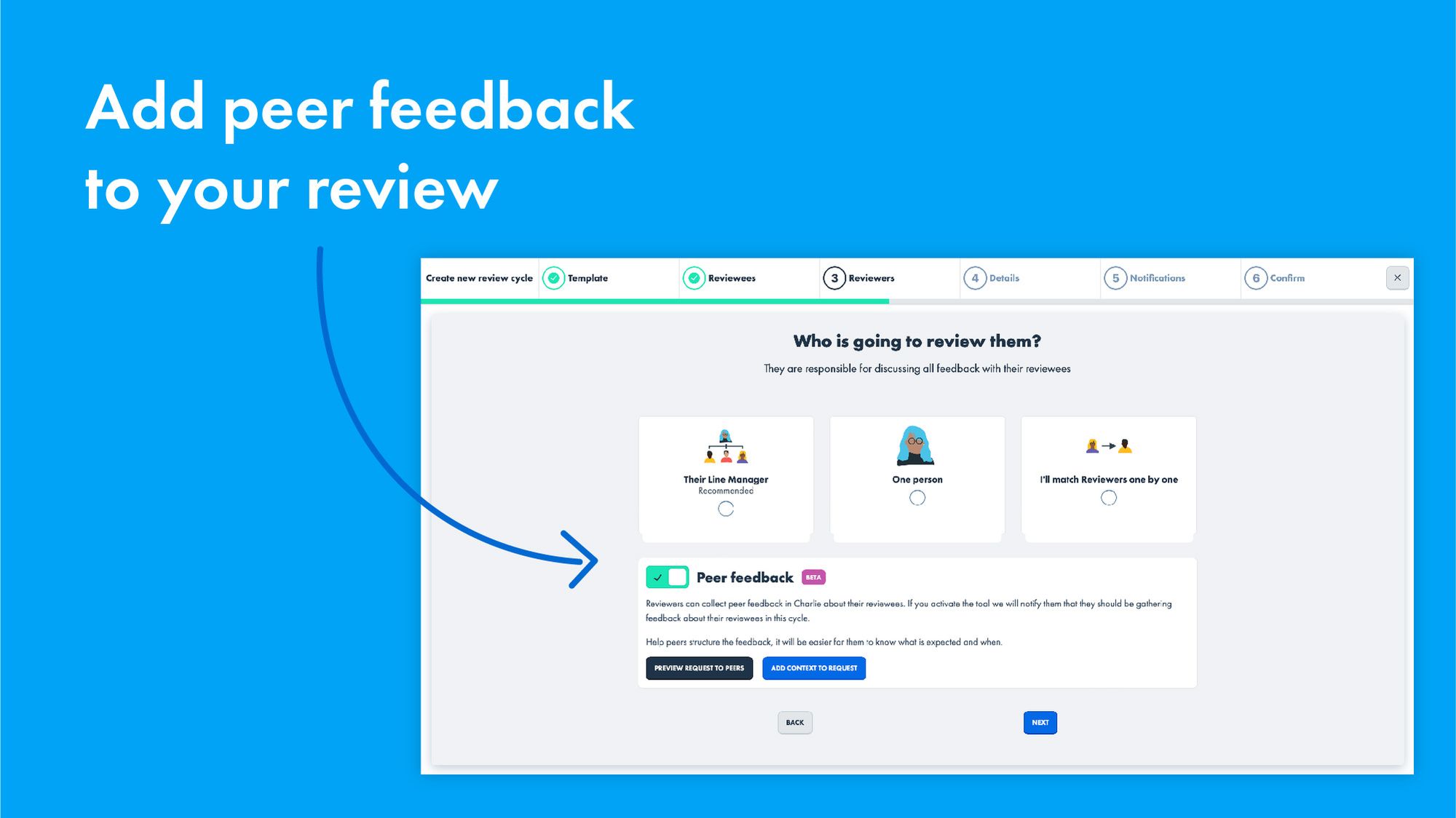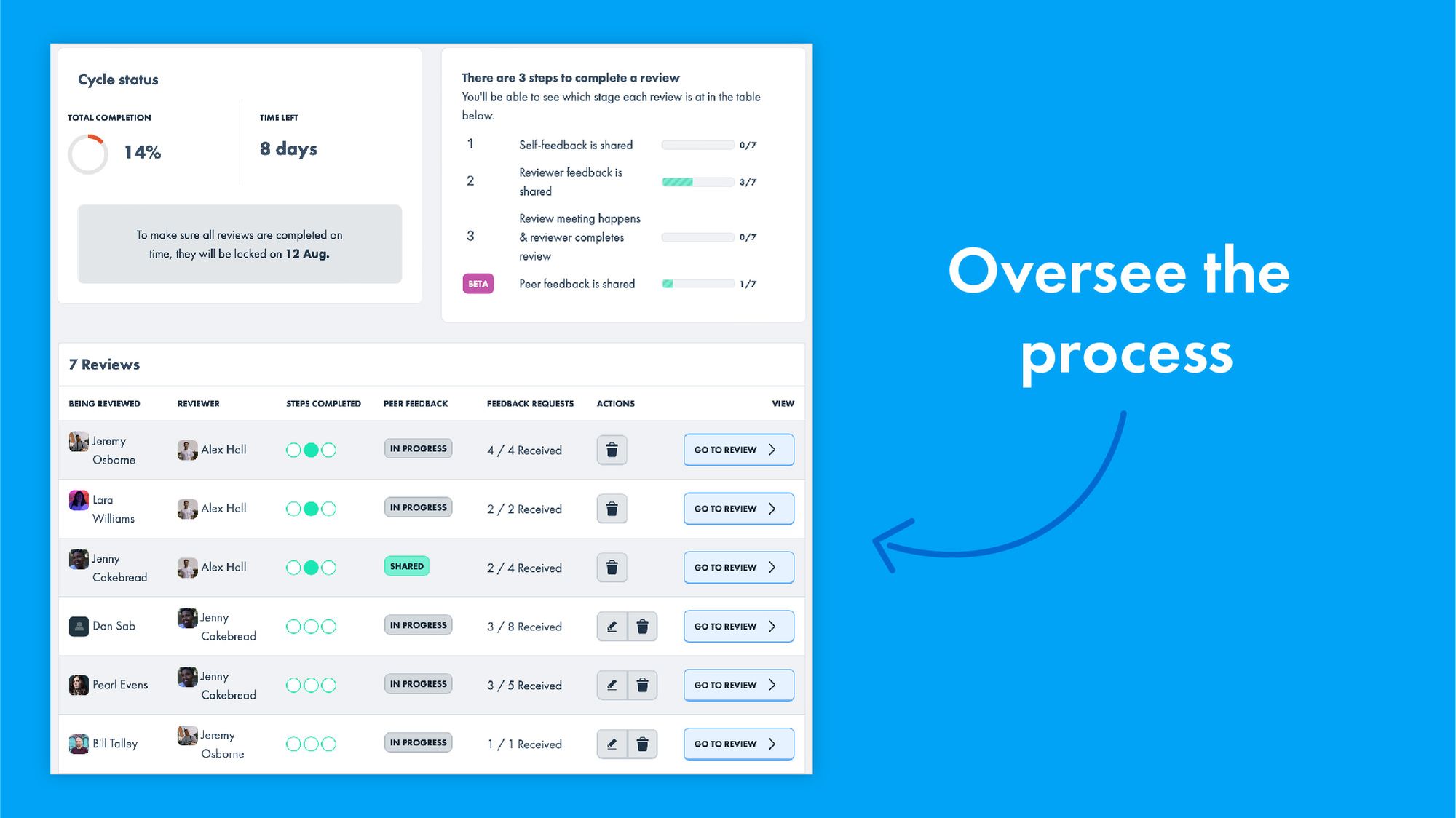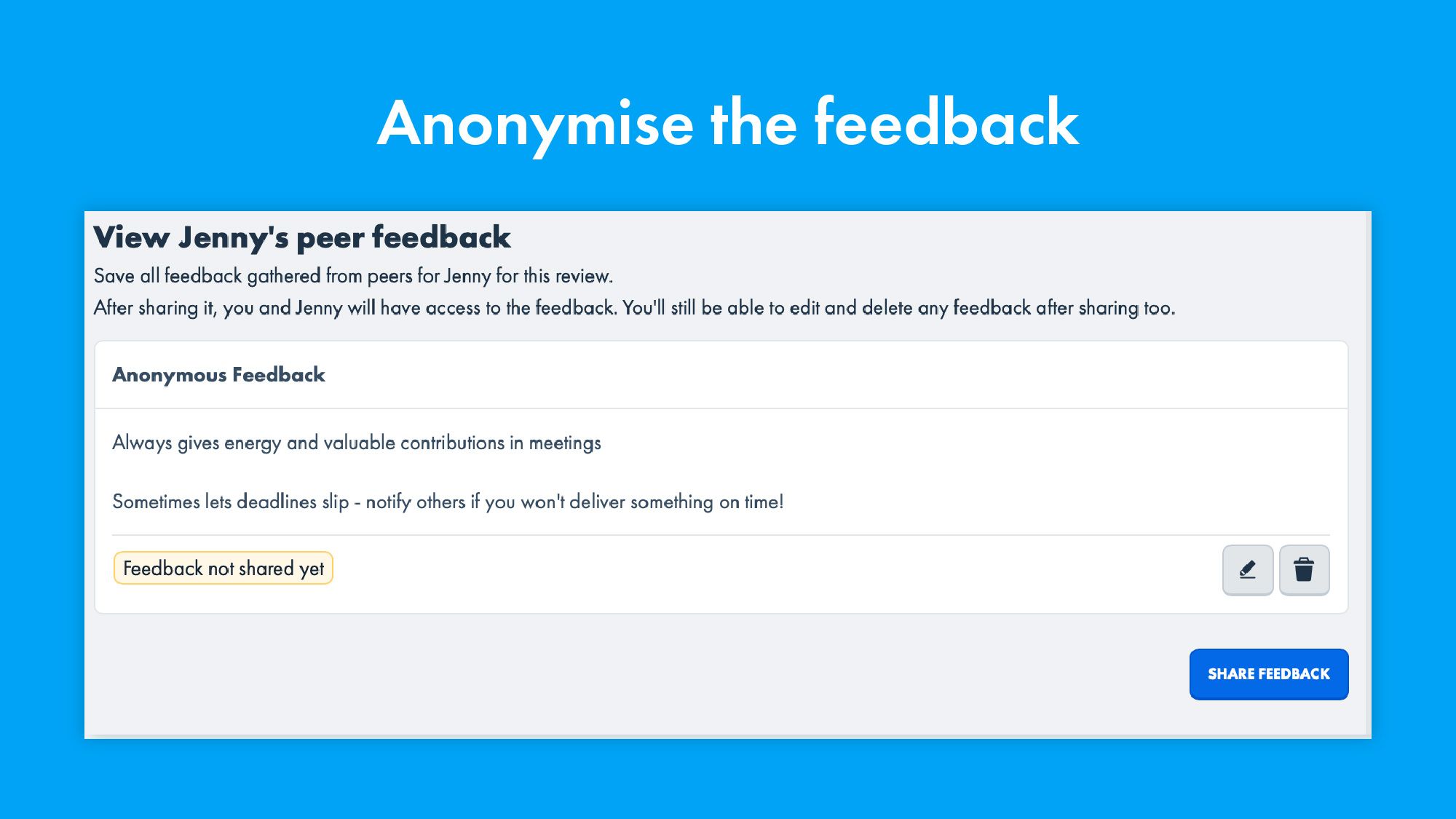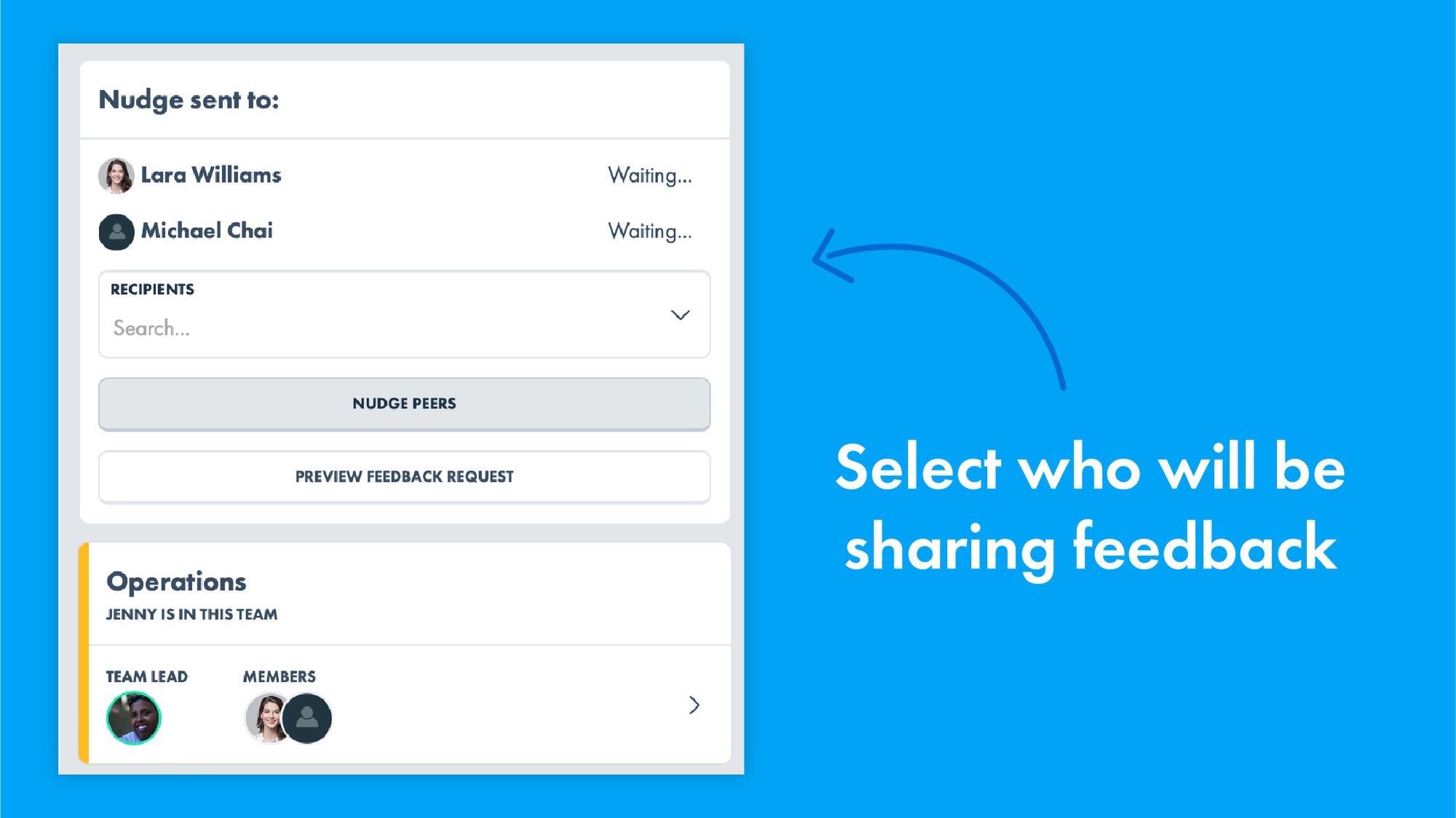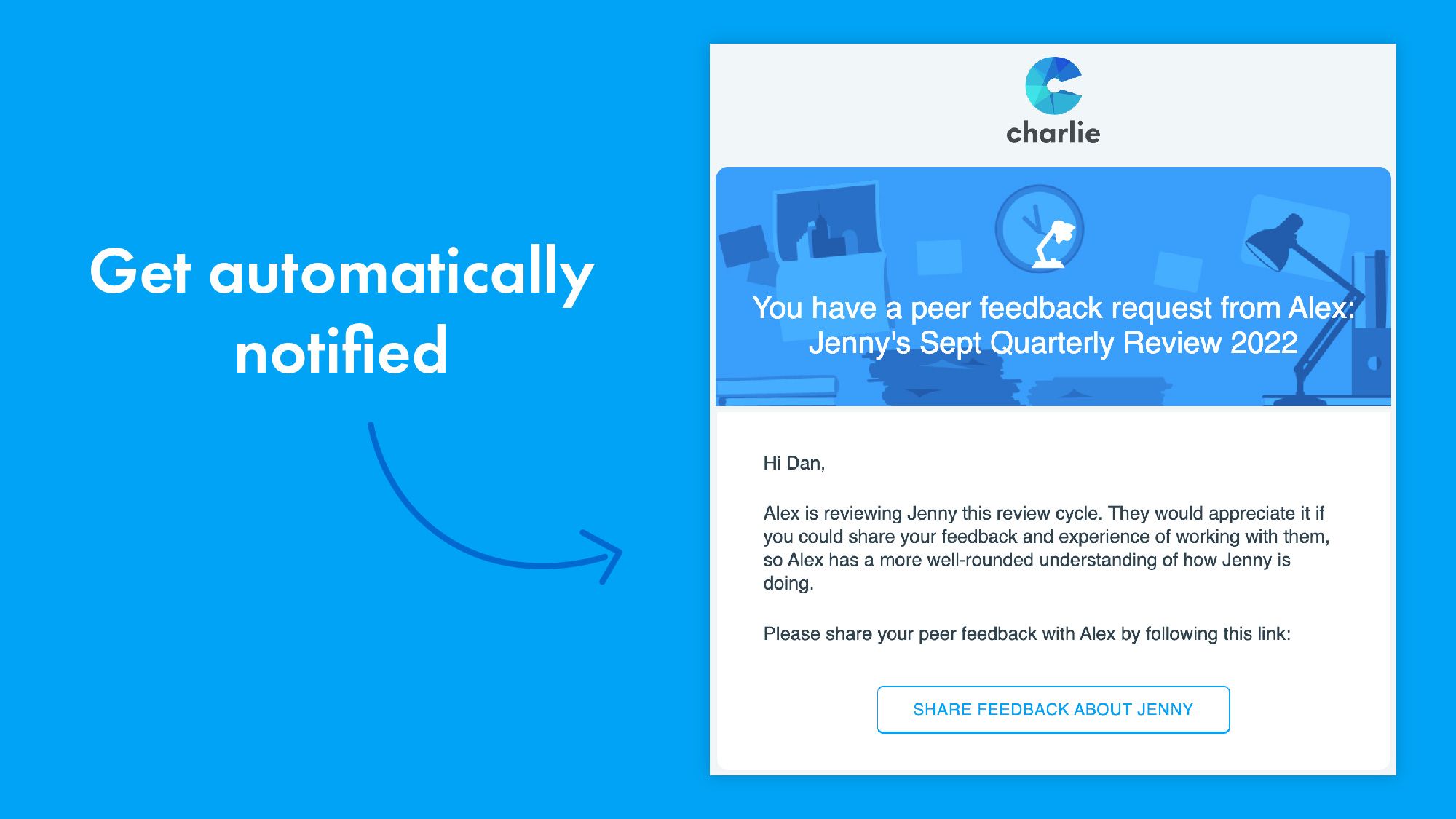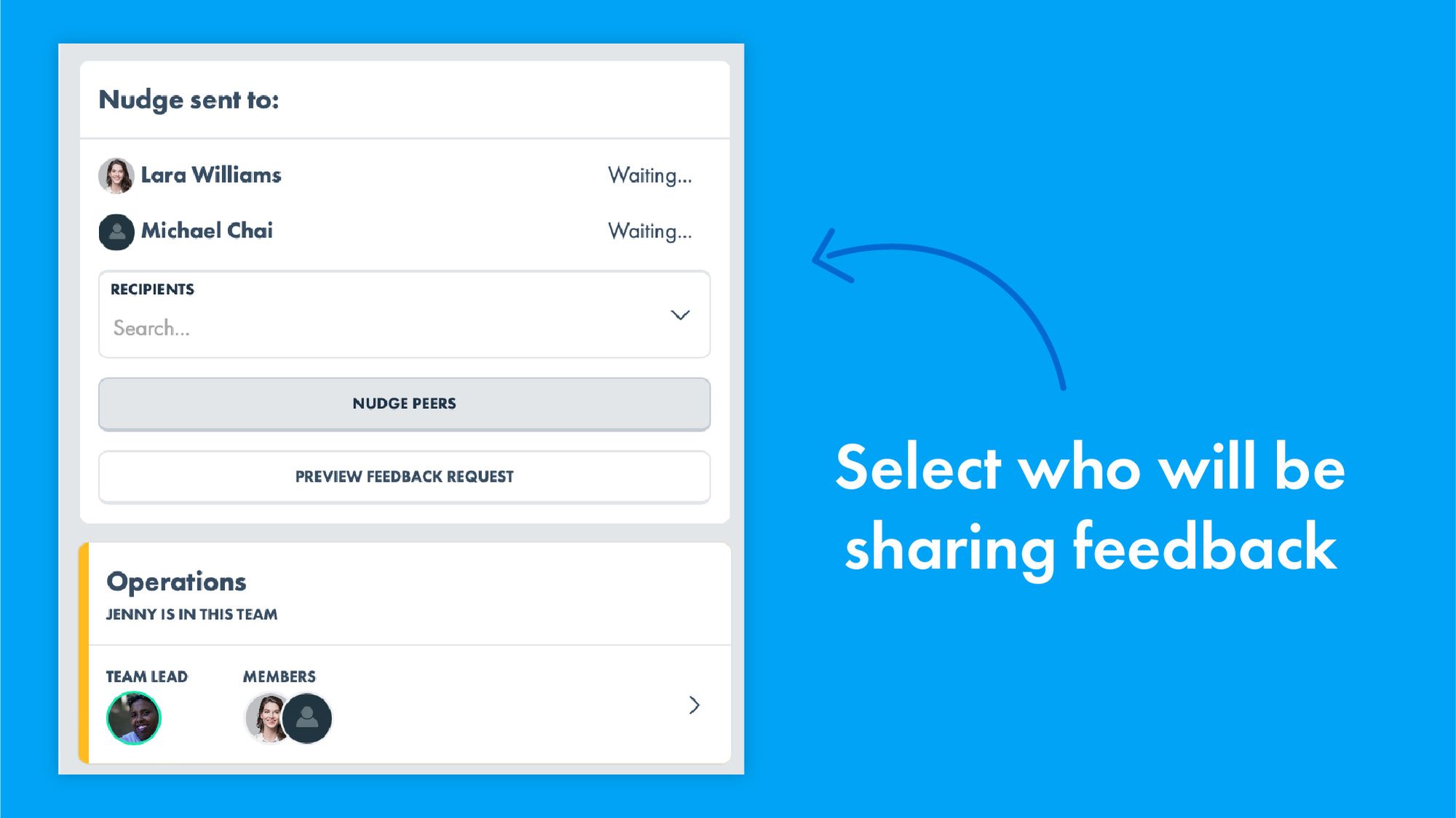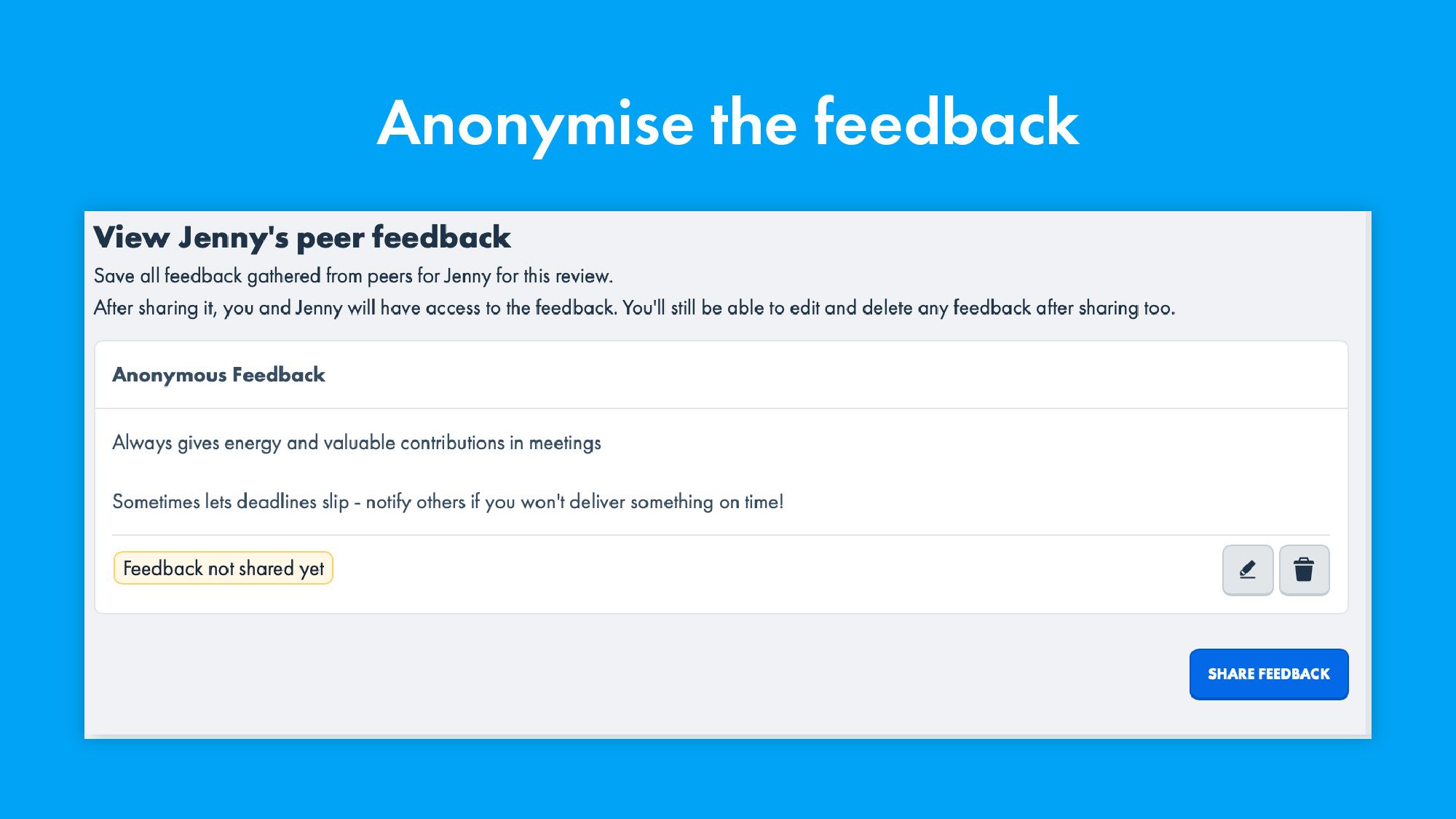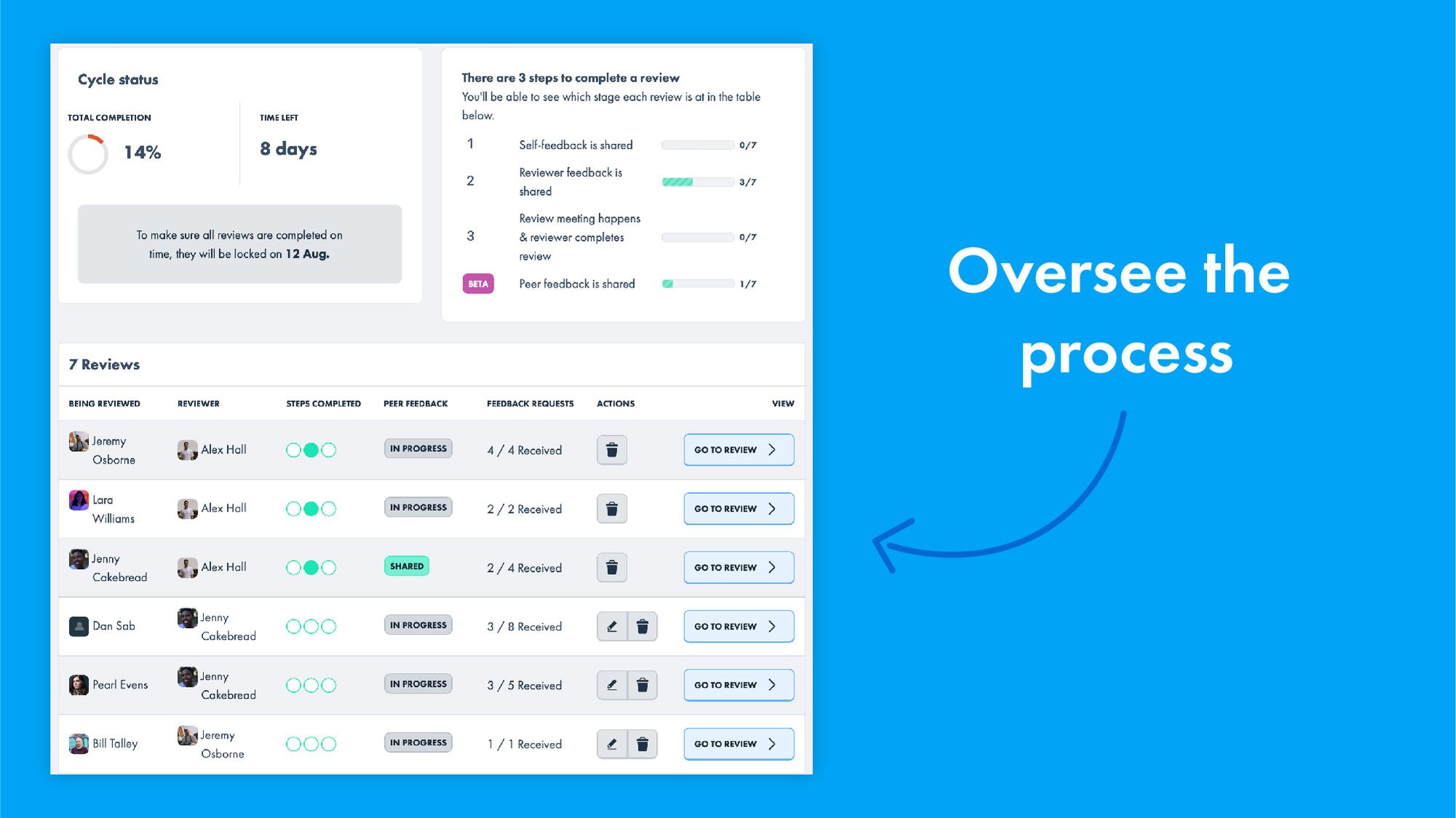What is a 360-degree feedback process?

A 360-degree review is part of an overall performance review process and gives employees the opportunity to get feedback from their peers, and not just from their managers.
The main difference with traditional performance reviews is that they’ll include an extra step on top of the general conversation led by managers with their direct reports.
In practice, that means:
- Team members receive feedback from their line managers (as normal) but also from their peers.
- Managers take all this feedback into account when making decisions around promotions and pay rises.
With more granular feedback, line managers can really understand how their team member is performing – especially when there are a lot of cross-functional teams, and team members and line managers don’t necessarily work closely on a daily basis.
By getting a lot of perspectives, a line manager is also able to notice areas that their team member excels at and that they wouldn’t have been able to pick up on before.
Ultimately, 360-degree feedback is a great way of encouraging growth and development by making performance evaluation a more collaborative experience for your business. But it is not that easy to get it done properly.
At CharlieHR, we spent the last year researching 360 degree feedback in all its forms. Our goal was to built a tool to make peer feedback as simple and straightforward as possible at small companies. This guide is a collection of all our learnings — we hope you find it useful!
What are the pros and cons of the 360-degree feedback system?
There are a few things to consider when thinking about 360-degree reviews for your business, so let’s see what the main pros are and what the most common cons – and how you can tackle the eventual difficulties that come with them.
Pros of including a 360-degree review process for your business
Here are the main reasons why you should consider implementing peer 360-degree feedback at your company.
1) Different perspectives = more opportunities for development
Depending on the manager’s background and their relationship with the employee, they may not be able to see through the team member’s performance and behaviours in their entirety.
If you’re striving for equality at your business, that’s where personal development will be impacted and where team members won’t get all the opportunities they deserve.
With 360-degree reviews, you’ll be able to address that by gathering feedback from:
- Different seniority levels in the business
- A variety of roles
- A pool of talent with diverse competencies, backgrounds and experiences
That’ll be super helpful for both team members and managers alike.
For example, if team members receive the same feedback about their performance from a range of different people, it’s more likely they’ll accept it and action it than if it came from their line manager only.
On the other hand, managers can get a clearer picture of the employee’s performance by using 360-degree reviews as a development tool, spotting areas of improvement they may have overlooked in the past.
And if performance appraisal has not been a manager’s forte, they’ll learn more about how to share their point of view by seeing everyone doing the same – benefiting both sides once again.
Ultimately, 360-degree reviews will fine-tune your performance management process, help you put together a continuous performance management strategy and offer more opportunities for development to your entire team.
2) Fairer processes = better retention rates
Being reviewed by one person can sometimes feel a bit daunting, and even unfair if your pay rises and promotions are reliant on one unique point of view.
If your team members feel like they’re not treated fairly, it’s likely they’ll feel some frustration and resentment that can easily lead to low employee engagement and their departure from the company.
Getting feedback from one person – a line manager – can also be riveted with what we call bias. 360-degree reviews then become crucial to walk the walk on DE&I and make sure you account for a diverse workforce.
By gathering feedback from a variety of backgrounds and experiences, you’ll decrease the potential for bias to creep in. A 360-review process will also help reduce any potential gaps in salaries and promotions by making sure everyone is treated fairly.
3) More dialogue = engaged and high-performing teams
It might sound pretty obvious, but people can’t improve unless you tell them where they fell short of expectations, and that’s where feedback becomes key.
By giving your team members access to 360-degree reviews, you enhance their capacity to receive constructive feedback about the work they’re doing and improve their self-awareness for the subsequent tasks they’ll be responsible for. In other words, 360 degree feedback is essential to boost your employee development.
Some businesses choose to have anonymous feedback, but we’d recommend not to, especially for a small business or startup. When you’re so small, it’s likely people are going to be able to identify where the feedback comes from, leading to potential conflict within the team and poor working relationships.
Instead, it’s better you look at fostering an environment where people feel comfortable sharing and discussing feedback. That will enable your team members to be more open and honest with each other, ultimately building a strong culture of feedback within your organisation.
Want to learn more about the importance of candid feedback? Listen to our podcast below:
Cons of getting 360-degree reviews for your business
360 reviews are not for everyone though. Feedback can be hard to digest, especially if you haven't developed a culture of open dialogue at your company. Let's have a look at the most common cons on implementing peer feedback:
1) 360-degree reviews = higher workload
Putting together performance reviews already takes a lot of your time and energy when you’re responsible for HR at a small business or startup. So if you include 360-degree feedback in the mix, you’re right to think it might be more time-consuming for you to manage.
However, it doesn’t have to be like that if you choose to automate your performance review process.
With HR software like CharlieHR, you can launch a review cycle in a few clicks and can easily automate 360 degree feedback as part of the process. Just pick one of the 360-degree templates available in Charlie, or create your own from scratch with a mix of multi-rater feedback and open-ended performance review questions.
Both senior leaders and team members can self-serve by requesting feedback to their colleagues via the platform, so everything it’s in one place.
You can also choose whether to anonymise responses or not, and the system will take care of sumbitting feedback questions and answers to the right people.
All you have to do is oversee the process on the Charlie HR portal to see who completed their performance reviews. No need to chase anyone – the software does it for you.
2) Peer feedback = tension between team members
It’s important to address the fact that getting feedback from your peers is difficult, especially if it’s not pleasant to hear.
Feedback is likely to create some tension within your team and that’s where it’s essential to handle it carefully.
Some people would argue that it makes more sense to deliver 360-degree feedback anonymously, but we believe it’s better to create an open environment and encourage dialogue.
That being said, line managers can still anonymise the feedback if necessary and even edit it before sharing it with the team member to avoid any tricky situations.
A 360 reviews tool helps make feedback second nature for your team, and not something they dread receiving. That’s why you should carefully pick who will be doing the reviewing (the respondents) and have a good balance of direct co-workers or people who worked on projects with that person.
3) More feedback = more support needed
360-degree reviews are great, but they only work if you follow up on the feedback the team member receives.
For example, if your team member receives negative feedback, there’s no point in simply leaving them to deal with it on their own. They need support from the whole team to be able to improve and make that part of their career development, and that means making sure everyone provides actionable and constructive feedback.
On top of providing examples of situations where the team member could improve, you need to follow up with regular check-ins as part of your feedback program, so they’re not left with a feeling of resentment from the feedback they received.
That’s where you can start putting together a personal development plan – building on that feedback, you’ll be setting goals that you can then review at your next performance review cycle.
You may find our guide below helpful to implement effective 1-1s and personal development plans at your business:

How to implement 360 reviews at your small business or startup - step by step
360-degree reviews can only happen at your small business if you already have a performance review process in place.
Of course, you could choose to do them manually:
- Set some time aside to come up with forms and processes
- Send emails to explain the process to the team
- Keep track of everyone’s progress on a spreadsheet
- Send chaser emails to people who haven’t completed it
It can definitely be done, but it’s likely to be a heavy weight on top of the HR tasks you already have.
If you choose, on the other hand, to automate the process you won’t have to worry about any of this.
All you have to do is choose the best performance management system for your small business.
Get the right 360-degree feedback system for your small business or startup
Choosing a performance review system will mean you’ll have to think about a lot of different aspects:
- Does it completely automate the performance review process?
- Does it include 360-degree feedback?
- How long does it take to set it up?
- Does it include other features I can use to automate more of my HR processes?
All these questions will rise up and need answers, and that’s where it’ll be useful for you to understand what’s best for your small business. If you’re a small to medium company looking to put solid growth and development foundations in place, we’d recommend to look for:
- Performance review software that saves you the most time
- Processes that are easy to set up, use and understand for you and your team members
- Opportunities to automate more of your HR processes all in one place so you don’t have to jump between platforms
- A solution at the right price
Announce the changes to your team
Once you’ve made a decision on which 360-degree feedback tool you should get, it’s important you announce any changes to your team.
You’ll need to outline the steps and the new processes with supporting documentation – and make sure they have it all on hand.
That’s where your choice of software will have been crucial – you’ll need to ensure that whatever tool you choose, it doesn’t make your HR admin more complicated than it needs to be and put your team off with tons of processes.
The best performance review platforms help team members get familiar with the new system by using step-by-step instructions and automatic notifications as employees go through the review process.
This way, the new platform roll-out is made easy and effortless, and your team can self-serve 90% of the time.
Have a clear process in place to add 360 degree feedback to your reviews
The most important part of implementing 360-degree feedback is to get a clear process in place. Here are the steps you should follow to get one that’s as seamless as possible.
1. Deciding who to ask for feedback
If you’re implementing 360-degree feedback at your business, the first step will be for line managers to decide who will give feedback to their direct reports.
As the person responsible for HR at your business, you might want to give some general guidelines for managers to pick the right respondents:
- Get them to think about the purpose of the review and what context you might be missing from it
- Recommend choosing team members that will be able to provide that additional context
- For managers’ reviews, it’s often helpful to ask their direct reports to provide feedback
Want to find out more about performance management? Check out our best performance management software guide.
2. Sending the requests for 360 degree feedback
Once that’s done, let people who have been selected know that they’ll need to provide feedback about their coworkers.
In Charlie, team members are notified via email and once their review has been completed, you’ll be notified as well. Just make sure you send it well in advance so they have plenty of time to do it.
3. Reviewing the 360 degree feedback
When team members complete their review, it’s not directly accessible to the team member that’s being reviewed.
Instead, their line manager is the one that gets access to it and gets to read it first – we’d recommend always providing identifiable feedback, but you can also anonymise it if you prefer.
4. Incorporating the 360 degree feedback into review conversations
Once a review cycle is complete, it’s time for both parties to have a conversation about it. The line manager schedules a meeting and goes through the items in the review, including the peer feedback just provided.
To make sure everyone gets the most out of the conversation, line managers should read the feedback beforehand and see if they can identify any recurring issues or praises – that way they can incorporate it into their own feedback, instead of addressing each point one by one.
It’ll also be a great way to have a conversation review that feels complete to the team member and where you can set a professional development action plan they’ll need to work on.
Monitor success and keep iterating on 360-degree reviews
Once everyone’s started getting used to the process and getting the hang of it, it’s important you monitor whether it’s successful.
First, make sure everyone is completing their part by overlooking the process from the dashboard.
If that’s not the case, it’s time for a friendly reminder of the processes your team members are supposed to follow.
Second, report on the success of your HR processes by auditing the way it’s performing, whether you had a performance review process in place before or not:
- Did you manage to free more of your time and focus on helping managers rather than running the whole process by yourself?
- Have you gathered feedback on what could be improved or what might be missing?
Processes are there to be iterated on, so it’s important you have a look at what could potentially be changed.
But if you really want to know what it’s like, it’s better you give it a whirl and try it out yourself – sign up today for a free trial.
Want to learn more about what is performance management? Have a look at our resources:
- Underperforming employees and how to deal with the situation
- How to use personal development plans at your business

